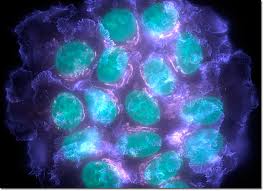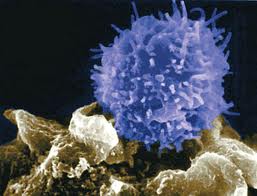- The immune system is the body’s primary defender against cancer. In a recent article in Science magazine, Dr. Senovilla and colleagues report a novel mechanism that cells of the immune system use to identify carcinogenic cells. They show that a protein called calreticulin, which normally resides in the endoplasmic reticulum, is present on the surface of polyploid (extra chromosomes) cells. This serves as a beacon for immune cells to destroy these cells and ultimately lead to the selection against them.
- Mammography (low dose x-ray imaging) is the most common breast cancer imaging technology, for early screening although many limitations exist. For example, it is estimated that the about 20% of cancers go undetected by mammograms leading to false negative diagnosis. Another issue with mammography is that the technology uses radiation and over time and repeated exposure could actually increase the risk of cancer. Computed tomography (CT) can reduce some of the radiation exposure but at the cost of lowering resolution of the images making it harder to detect some cancers. Dr. Zhao and colleagues from the California NanoSystems Institute at UCLA devised a new method for 3D imaging using phase contrast x-ray in combination with a novel image reconstruction program. Researchers report a 74% reduction in radiation dosing, image acquisition time, increased resolution and contrast.
- A well-documented phenomenon is the result of chronic inflammation to induce carcinogenesis. Inflammatory cells secrete cytotoxic molecules that are intended to kill cancerous cells but during chronic inflammation, repeated exposure to cytotoxic molecules can lead to DNA damage. This damage can result in oncogene activation or tumor suppressor gene inhibition. Researchers at the University of North Carolina at Chapel Hill, Chapel Hill show that colitis (inflammation of the large intestine, colon) can also lead to imbalances in the natural microflora. Imbalances of certain microorganism with genotoxic (DNA damage) ability can lead to DNA damage in the intestine and initiate carcinogenesis.
- Resistance to cancer development varies greatly from species to species. Anti-cancer adaptations lend cells the ability to deal with genomic alterations potentially leading to carcinogenesis. Subterranean rodents, blind mole rats, Spalax (BMR) display resistance to cancer development. Researchers at the Department of Genetics and Complex Diseases at Harvard School of Public Health found that cells from BMR animals after multiple replication cycles perform concerted cell death in response to hyperproliferation as an anti-cancer mechanism.
- Chemotherapeutic, Doxorubicin is a common treatment option for a wide range of cancers. One of the most serious side effects is cardiomyopathy (damage to heart muscle) by a mechanism that up to now remained unclear. Doxorubicin inhibits cellular replication by binding DNA and inhibiting the function of the DNA detangling enzymes, topoisomerase-II-α and –β (Top2-α and –β) and Top2-α is considered a marker of cell proliferation and thus this drugs target for cancer treatment. Dr. Zhang and colleagues show that Top2-β, the other target of this drug is expressed on heart tissue and is inhibited by Doxurubucin providing an explanation for its cardiotoxicity.



